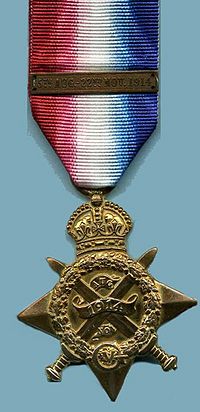1914 Star
Bar
5th Aug. - 22nd Nov. 1914: The bar was awarded to those who served under fire or were present on duty within range of the enemy mobile artillery in France or Belgium between the above dates and on the strength of units and formations contained in the official lists.
Description
A bronze star measuring 1.75 inches in width. A four-pointed star has its uppermost point replaced by a crown. Across the face of the star are two crossed swords (blades upward), the blades and hilts of which protrude and thus form additional points of the star.
Obverse
On the obverse, in the centre are three scrolls; on the top scroll is the month AUG, with the date wreath and on the bottom of the wreath is superscribed the Royal Cypher GV (with the V inside a larger G).1914 and the month NOV on the middle and bottom scrolls. The three scrolls are surrounded by a laurel.
Reverse
The reverse is plain and displays the recipient's number, rank, name and unit. The Canadian 1914 Stars most commonly show: 2-STA.HOSP.C.A.M.C. .
Ribbon
The watered ribbon is 1.25 inches wide and shaded left to right: red, white, and blue. The recipient of a bar wears a small silver rosette on the ribbon in undress.
Mounting
The ring for suspension is stamped out solid with the piece and is attached to the top point of the crown.
Dates
The 1914 star was authorized in April 1917, and the bar on 19 October 1919.
Naming
Plain except for naming (See REVERSE).
Issued
There were 160 awarded to 2nd Canadian Stationary Hospital members who served with the British Expeditionary Force beginning 6 November 1914. A few Canadians who were attached to British Units also received the medal.
There were two Signals recipients of the 1914 Star, Sergeant-Major Shergold, MC, DCM and Lance-Corporal R.G. Sheale, DCM both of whom served with 1st Signals Company, Royal Canadian Engineers.
Approximately 378,000 medals including 145,000 bars were awarded to members of the British Expeditionary Force.
